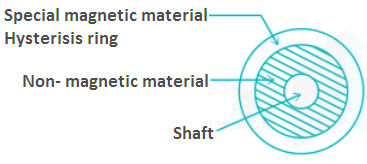The hysteresis motor is well known for its noiseless operation. Therefore it is generically used in audio recording-related equipment. In this article, I am discussing the working principle of hysteresis motor.
It is a single-phase motor whose operation depends upon the hysteresis effect i.e. magnetization produced in a ferromagnetic material lags behind the magnetizing force.
The main parts of a hysteresis motor are the stator and rotor. The rotor is a smooth cylinder of magnetically hard steel, without winding or teeth. The construction of the stator and winding arrangement may be like a capacitor motor or a shaded pole motor.
In the case of a capacitor-type stator, both the windings (i.e. main as well as starting winding) remain connected in the circuit during running operation as well as at the start. The value of capacitance is so adjusted as to result in a flux revolving at synchronous speed. The motor produces uniform torque and is quiet in operation but it occupies more space and is more costly.
The motor with a shaded pole-type stator is smaller in size and cheaper in price but it produces non-uniform torque that results in noisy operation.

The rotor is made up of hard chrome or cobalt or steel. Since it is a heavy material, the spider (center portion of the rotor) is made up of aluminum. The use of aluminum reduces the weight of the rotor which results in speed improvement.
Working Principle of Hysteresis Motor
Hysteresis motor starts like a single-phase induction motor and runs like a synchronous motor. When the stator is energized from a single-phase supply, a synchronously-revolving field is produced due to split-phase operation.

The revolving stator flux magnetizes the rotor. Due to the hysteresis effect, the axis of magnetization of the rotor will lag behind the axis of the stator field by hysteresis lag angle α as shown in the figure. If the rotor is stationary, the starting torque produced is given by:
Ts α φsφr sinα
Where, φs = stator flux; φr = rotor flux
After starting, the rotor rotates at synchronous speed with uniform torque. Because φr and φs are now constant. When the rotor accelerates, the lag angle α remains constant since the angle α depends merely upon the hysteresis loop of the rotor and is independent of the rate at which the loop is traversed. The motor, therefore, develops constant torque from the standstill to synchronous speed.
After reaching synchronism, the motor continues to run at synchronous speed and adjusts to run at synchronous speed and adjusts its torque angle to develop the torque required by the load.
Characteristics of Hysteresis Motor
A hysteresis motor can synchronize any load which it can accelerate, no matter how great the inertia. It is because the torque is uniform from standstill to synchronous speed. Hysteresis motor produces very smooth and soundless rotation.
The rotor takes on the same number of poles as the stator field. Thus by changing the number of stator poles through a pole-changing connection, we can get a set of synchronous speeds for the motor.
Advantages of Hysteresis Motor
The advantages of the hysteresis motor are as follows:
- It is very smooth in operation.
- It is quiet in operation.
- It is very suitable for accelerating inertia loads.
Applications of Hysteresis Motor
While audio recording, noise-less operation of recording equipment is very essential. Due to quiet operation and the ability to derive high inertia loads, hysteresis motors are used for timing devices and precision audio equipment.
Thanks for reading about the working principle of hysteresis motor and hysteresis motor working principle .